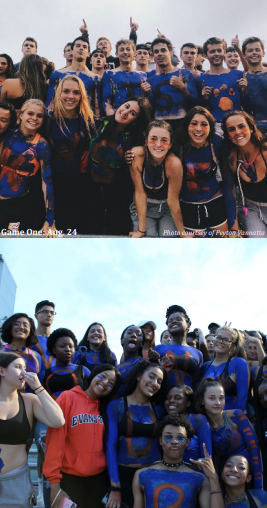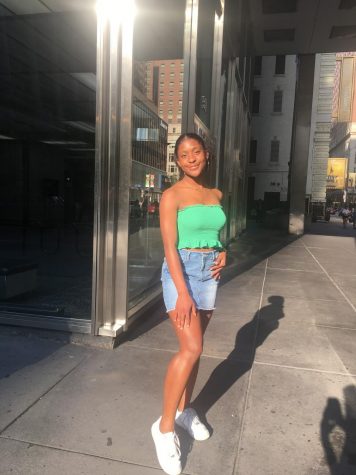Blue Crew: history of racial exclusion, tension compels students to make change

Game 1, Aug. 24 (top) Game 2, Aug. 31 (bottom)
October 2, 2018
Inadequate communication between white students and students of color, segregated friend groups, and a historically white student section leave ETHS seniors wondering if Blue Crew, a typically senior-lead spirit group, will ever be inclusive for all races alike.
Blue Crew began in 2006 as a school sponsored club in an attempt to target students’ lack of school spirit, and has since transformed into a student-run group. Since its start, Blue Crew has comprised of predominantly white students, most of whom belong to the same few friend groups. Typically, these students paint themselves blue and orange at football games and cheer in the student section at basketball games.
“The first game [Aug. 24] was an issue. There was only one group of predominantly white people that did paint for that game, and no one else really knew about it,” senior Teagan Hueneke says.
At the painting session preceding the first game, one white student was reportedly wearing an afro wig and a gold chain. Sources report that this student was asked to remove those items, but the student did not remove them until he was told to later on at the game.
The history of racial prejudice at sporting events, and complaints about the first game’s Blue Crew, triggered a response from members within Students Organized Against Racism [SOAR], who specifically advertised painting to people of color for the second football game.
“In SOAR, we talk a lot about what goes on in our community, and we noticed the lack of POC [people of color] in Blue Crew, so we collectively decided to get our friends of color together and join the group for the second game [Aug. 31],” senior and member of SOAR, Nicholas Rosenfeld expresses. “SOAR feels that Blue Crew is meant to be a senior experience, not a white senior experience.”
Although many affirm that the painting session for POC did its job in recruiting more students of color for the second game, the division between POC and white students remained.
“The second game was better; it was a different group of people and it was more diverse, but I think that there was also like a black section and white section within that group, right next to each other. It was really divided. I looked up and one side was black, one side was white,” senior Kathlyn Etyem recalls. “I think that even though our goal is to get more POC, it’s also to make sure that we all work together, so that it’s not just friend groups divided by race.”
However, a miscommunication preceding the third football game against James B. Conant High School on Sept. 7 led to a student section even more segregated than at the previous game.
“The last time we had painted for the football game, there were many white people there. One of my friends had contacted two or three of these white people, and they had told her that they were going to paint for this game, and that they were going to meet us at Mason Park. Nobody met us there,” senior Devea Williams says. “We get to the football stadium, and we’re just there alone, and then a few white people show up, and say they’re expecting 35 more people to come. These 35 students come, and they’re wearing all white.”
Insufficient communication spurred tension between students at the game.
“We were confused because if the white people knew they weren’t going to paint, why didn’t they let us know? It was very uncomfortable because even the white people who told my POC friend that they were going to paint were wearing all white,” Williams adds. “It was really upsetting, because, if you look at it, the white kids are all wearing white, and the people of color are painted in colors.”
Etyem offers that the lack of interracial friend groups is the cause of the racial divide. Still, some believe that a separate painting session for POC and white students contributed to the issue of segregation.
“I don’t think anyone wanted to go out of there way to not include anybody, I just think that that’s how it came off, because everyone is so stuck with their friends, and not really willing to mingle at this point in high school. That’s really what segregates us,” Etyem iterates.
On Tuesday, Sept. 11, SOAR held a debriefing of the three most recent football games during their office hours, advertised to all students. Their goal is not to take over the movement towards a more-welcoming and connected Blue Crew, but instead to further its success.
“The plan is for this not to be SOAR’s baby, but instead to become the Blue Crew experience where all seniors can join the group and feel comfortable,” Rosenfeld emphasizes.
However, only two non-SOAR members showed up to the debriefing. Etyem suggests that the low turnout may have been because “some people look at SOAR and get intimidated.”
Instances of segregation and racial insensitivity are not new to ETHS sporting events; Athletic Director Chris Livatino affirms that especially in the past few years, the front rows of the student section at football and basketball games are composed of mostly white students.
2018 graduate Caitlin Strickland recalls, “specifically at basketball games, students of color were usually at the back of the section or pushed to the side to another portion of the bleachers in Beardsley, as more white students would come to sit with their friends.”
At the last home boys varsity basketball game last year, Strickland reports a group of POC went early to the game, and sat in the front few rows.
“As white students came in, we received some unsettling looks but ignored them. They sat behind us, and some passive aggressive comments were made, while then also sending people down to come talk to us about getting ‘their seats’ back,” Strickland says. “At around halftime, [blown up noise makers] began to get balled up and thrown at us from the white students behind us. By the third quarter, it escalated into actual garbage being thrown at us. After the game, I left with a wet winter jacket, and a few students had actually been hit in the back of the head with what was being thrown down.”
Etyem and Hueneke initially believed that a possible solution to the student section’s exclusion is rebuilding Blue Crew as a school-sponsored club; however, the persistent divisiveness of the senior class, present during the third game, changed their minds.
“We can’t create a whole new club for the school when the seniors aren’t together like they should be,” Hueneke states.
With the help of SOAR members and Athletic Director Chris Livatino, Etyem and Hueneke put together a meeting for students to talk about Blue Crew, and about how to build community in racially divided social scenes, on Tuesday, Sept. 18.
“I do want everybody to feel welcome and a part of that opportunity [Blue Crew]. If we’re just expecting that everyone wants to cheer the way the typically white section cheers, then that’s messed up too. There has to be some dialogue that goes on between students,” Livatino says.
The open conversation began with students speaking on their emotions regarding the football games; specifically, how Blue Crew felt unwelcoming to many POC. Nearly all of the 40 students who attended the meeting agreed that in order to create an inclusive Blue Crew, every detail about Blue Crew (what the theme of the game is, what students should wear, what time everyone should meet) must be broadcasted to every student, perhaps through social media, Remind or school email.
Various seniors also made the point that students must make an effort to form relationships and connect with people of different races and social circles.
“An invitation is not enough. Ask your POC friends to come, and offer them a ride, or ETHS gear to wear. Be proactive,” senior Olivia Nicholson says. “With the combination of getting involved in SOAR and actively trying to include others, you’ll actually make a difference.”
The conversation was cut short, and SOAR decided last-minute to continue it after school during their office hours. While no conversation can resolve the high school’s history of racial prejudice and segregation at sporting events, SOAR agrees that acknowledging and openly discussing these instances of racism will contribute to making ETHS a more inclusive and welcoming community.
Sept. 21, 2018 was the homecoming football game against Maine South High School. “[The homecoming game] definitely wasn’t as segregated as the other games,” Williams remembers. “But in the future, I’d like to see more cheers from all of us together. I’ve noticed that if a white person starts a chant or something more white people start to participate, but if a POC were to do it, it’d be more POC being attentive to those chants.”
Currently, it is the students, not the school or administration, who lead and control the student section. As students continue to confront the existing racial division at sporting events and other social scenes through open conversation, they are attempting to work towards the end-goal of a unified student section.
tended the meeting agreed that in order to create an inclusive Blue Crew, every detail about Blue Crew (what the theme of the game is, what students should wear, what time everyone should meet) must be broadcasted to every student, perhaps through social media, Remind or school email.
Various seniors also made the point that students must make an effort to form relationships and connect with people of different races and social circles.
“An invitation is not enough. Ask your POC friends to come, and offer them a ride, or ETHS gear to wear. Be proactive,” senior Olivia Nicholson says. “With the combination of getting involved in SOAR and actively trying to include others, you’ll actually make a difference.”
The conversation was cut short, and SOAR decided last-minute to continue it after school during their office hours. While no conversation can resolve the high school’s history of racial prejudice and segregation at sporting events, SOAR agrees that acknowledging and openly discussing these instances of racism will contribute to making ETHS a more inclusive and welcoming community.
Sept. 21, 2018 was the homecoming football game against Maine South High School. “[The homecoming game] definitely wasn’t as segregated as the other games,” Williams remembers. “But in the future, I’d like to see more cheers from all of us together. I’ve noticed that if a white person starts a chant or something more white people start to participate, but if a POC were to do it, it’d be more POC being attentive to those chants.”
Currently, it is the students, not the school or administration, who lead and control the student section. As students continue to confront the existing racial division at sporting events and other social scenes through open conversation, they are attempting to work towards the end-goal of a unified student section.
*A shorter version of this article was published in the Sept. 28 issue of The Evanstonian.









